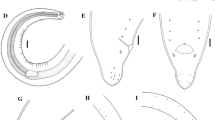Abstract
The functional morphology of the scolex of two species ofTetrabothrius from penguins from Bouvet Island in the Antarctic as revealed by scanning electron and light microscopy is described. These two species,T. pauliani from chintrap penguins (Pygoscelis antarctica) andTetrabothrius sp. from macaroni penguins (Edyptes chrysolophus), possessed scoleces with a somewhat different appearance and the way in which they attach to the host gut also turned out to be different. InT. pauliani the auricles were well developed and played a major role in the attachment process while the bothridia functioned as lateral shallow suckers. InTetrabothrius sp. the auricles were very small and played an inferior role in the attachment process while the bothridia acted as powerful anteriorly directed cup-like suckers.
In addition the definition of and the difference between cyclophyllidean acetabula and Tetrabothriidean bothridia are briefly discussed.
Similar content being viewed by others
References
Andersen K (1975a) Comparison of surface topography of three species ofDiphyllobothrium (Cestoda, Pseudophyllidea) by scanning electron microscopy. Int J Parasit 3:561–571
Andersen K (1975b) The functional morphology of the scolex ofDiphyllobothrium Cobbold (Cestoda, Pseudophyllidea). A scanning electron and light microscopical study on scoleces of adultD. dendriticum (Nitzsch),D. latum (L.) andD. ditremum (Creplin). Int J Parasit 5:487–493
Baer JG (1932) Contribution a l'étude des cestodes des cétacés. Rev Suisse Zool 39:195–228
Baer JG (1954) Revision taxinomique et étude des Cestodes de la famille des Tetrabothriidae, parasites d'Oiseaux de haute mer et de Mammiferes marins. Mém. Univ. Neuchâtel Sér. in-quarto T. 1. 121 pp.
Fuhrman O (1932) Les Tenias des Oiseaux. Mém. Univ. Neuchâtel 8:385 pp.
Nybelin O (1922) Anatomisch-systematische Studien über Pseudophyllidian. Göteborgs Kgl. Vetenskaps-Akad. Handl. 26:1–228
Rees G (1956) The Scolex ofTetrabothrius affinis (Lönnberg), a Cestode fromBalaenoptera musculus L., the Blue Whale. Parasitology 46:425–442
Schmidt GD (1970) How to know the Tapeworms. W.M.C. Brown Company Publishers, Dubuque, Iowa. 266 pp
Skrjabin KI (1955)Helminthofauna of Marine Mammals (Ecology and Phylogeny). Israel Program for Scientific Translations, Jerusalem 1968. 522 pp
Spätlich W (1909) Untersuchungen über Tetrabothrien. Ein Beitrag zur Kenntnis des Cestoden-Körpers. Zool Jahrb Anat 28:539–594
Wardle RA, McLeod JA (1952) The Zoology of Tapeworms. The University of Minnesota Press, Minneapolis.
Wardle RA, McLeod JA, Radinovsky S (1974) Advances in the Zoology of Tapeworms 1950–1970. The University of Minnesota Press, Minneapolis
Yamaguti S (1959) Systema Helminthum, Vol II.The Cestodes of Vertebrates. Interscience Publishers, Inc., New York
Author information
Authors and Affiliations
Rights and permissions
About this article
Cite this article
Andersen, K.I., Lysfjord, S. The functional morphology of the scolex of twoTetrabothrius Rudolphi 1819 species (Cestoda; Tetrabothriidae) from penguins. Z. Parasitenkd. 67, 299–307 (1982). https://doi.org/10.1007/BF00927665
Accepted:
Issue Date:
DOI: https://doi.org/10.1007/BF00927665




